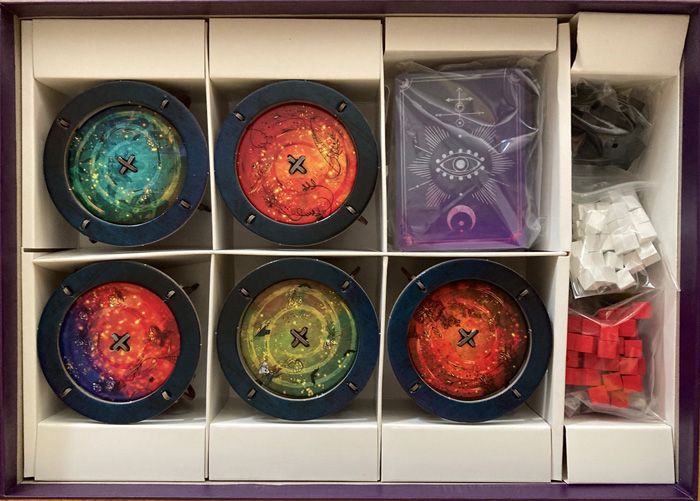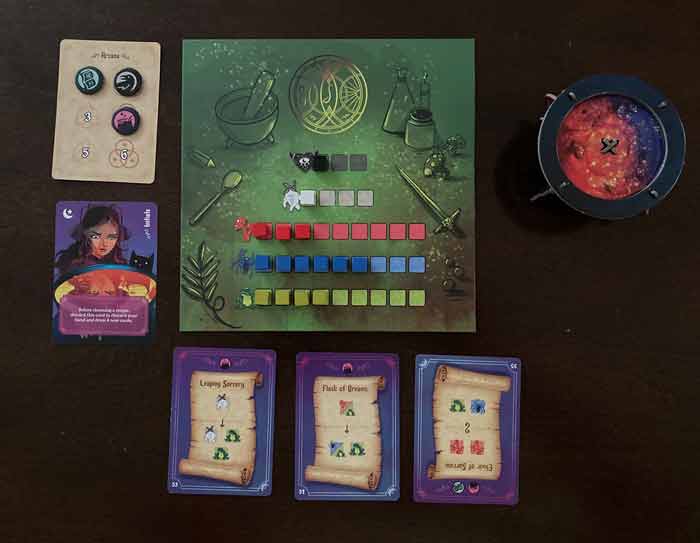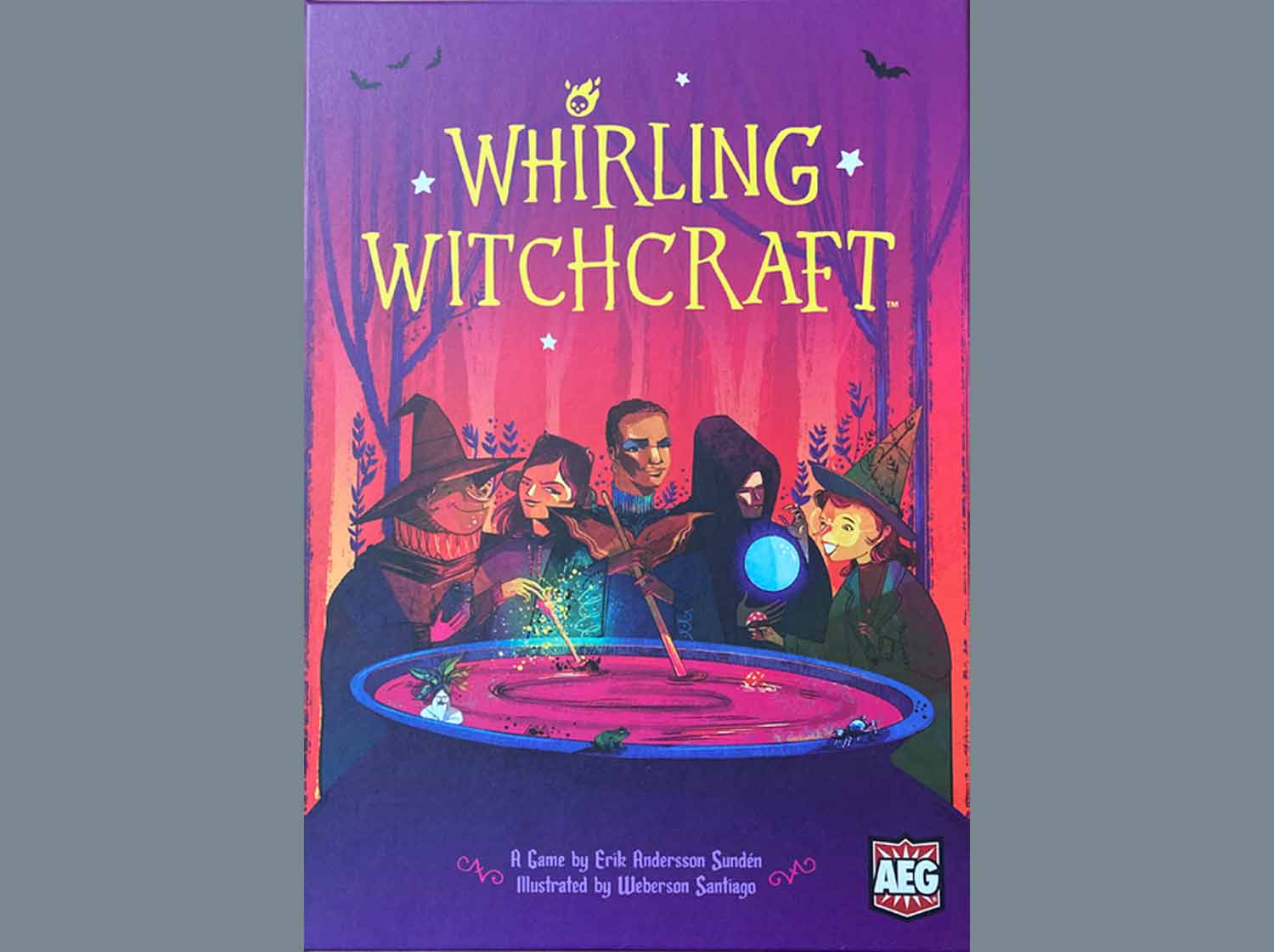Whirling Witchcraft is a game published by Alderac Entertainment Group. The premise of the game is for players to take on the role of witches brewing powerful ingredients. Players pass their ingredients in hopes of blowing up their neighbor's pot before their own pot is blown up. When a player has no room to absorb the ingredients passed to them, they go back to the witch that sent them. The first witch to have five ingredients passed back to them is the winner.
This post is broken into the following 3 sections, feel free to jump directly to one:
- General summary - consisting of information about overall enjoyment, theme, replayability, and upgrades
- Complexity - consisting of information about the rulebook, setup, player turns, and overall learning curve
- Player turns - consisting of game type, game flow, rule you are likely to miss, and favorite aspect
General Summary
Number of players we had: 4
Our play time (not including setup): 45 minutes
Overall enjoyment

Everyone in our group really liked playing this game. We instantly liked the theme, artwork and premise, and while playing enjoyed passing the 3-D cauldrons and the card drafting. Since it was our first game we all had the same character ability, but we will definitely play with some of the other character abilities next time. This is a fun and easy game to learn and teach new players.
Whirling Witchcraft has a surprising amount of strategy considering it is a smaller game. The first few rounds of the game start slowly, but the strategy builds quickly as players add a new ingredient recipe card each round. In later rounds, when players have 5+ ingredient cards they can build that turn, it gets slightly chaotic but in a fun way. Each player works to utilize as many of their available ingredient cards so they can pass the most possible ingredients to the player on their right. Additionally, each ingredient removed from their workbench to be used as input for an ingredient recipe card helps reduce the odds their workbench will blow up once the player next to them passes a cauldron to them.
There is definitely a balancing act between strategically building ingredients to pass while removing those ingredients from your workbench that are likely to be passed to you. Players truly start to find themselves scrambling at the end no matter how strategic they were and we really liked that. This game also forces people to adapt their strategies over time as you are not playing in a vacuum. The players next to you greatly impact your game.
If we had to pick something that frustrated us, it was that the player aide cards were on the back of the cards players use to track their arcana tokens. This means there are not enough player aides unless there are less than five players, and unless you have only two players, some people still will not have the player aide. This seemed like a small detail to overlook but since the game does not have that many phases and steps, they aren't really that necessary.
Also, a couple of times we ran out of a certain ingredient cube - I imagine this would happen more often with five players. This is easy enough to work around, but it would have been better if more were included.
Theme

We absolutely love the theme of this game for several reasons. Though Halloween is one of my favorite holidays, everyone in our group loved the theme. This is a small game, with smaller player boards and no group game board - but it doesn't need it. Each player board is wonderfully unique in colors and images, the ingredient cards are adorable and unique, and the cauldrons are also unique.

Also, it's worth noting that while the box does not have a custom plastic insert, it has a segmented insert with spots to protect each cauldrons, a spot for cards, and a spot for the tokens. I was impressed this was done since smaller games often skip this step.

Replayability

There are several things that increase the replayability of this game, including:
- It plays very differently based on your player group.
- There are 17 personality cards, 13 of which are unique.
- There are 60 ingredient cards, which we did not get through in a single game.
- It can be set up in minutes, taught very quickly, and is appropriate for any player group.
Upgrades
As far as I know, there are no available upgrades for this game.
Complexity
Rule book
The rule book is succinct and well organized with lots of images to explain the different parts of the game. I will say that for some reason the fact that the steps of each phase had a short description then longer explanations below threw me off the first time I read the instructions. I am used to a rule book stating, "there are 4 phases to each round: A, B, C, D", and then explaining those in detail. I ended up skipping the short descriptions and reading the long descriptions to our group which made more sense for us.
Another thing worth mentioning are the long explanations of abilities for the unique personality cards on the last page inside the rule book.
Setup
Whirling Witchcraft is easy to set up, taking about 5-10 minutes. The recipe cards are shuffled, and along with the ingredient cubes, are placed into the middle play area so all players can reach them. Players take a player board, cauldron, set of arcana tokens and tracking card, a personality card and four recipe cards. Players then add ingredients to their workbench aka player board based on their character card and you are ready to begin.

Turns
One of the things that makes this game quick and engaging is that most of the steps in both phases all players are playing at the same time. For example, players simultaneously choose and reveal recipe cards, produce ingredients, pass cauldrons and player cards, and fill up their workbench from passed cauldrons. The arcana can also be simultaneous, but we found it easier to let each player who had a triggered effect resolve one at a time. Even doing this step one-at-a-time, this step did not take very much time.
Overall learning curve
The overall learning curve of this game is low, though it does take adapting and strategy to win. There are two phases, the study and brewing phase, which are broken in several steps per round. In the study phase players secretly choose which recipe card to play next, reveal and resolve arcana. In the brewing phase players produce ingredients, pass and resolve cauldrons and then pass their remaining player cards if there is no winner.
While it is easy to learn how to play this game, it can be far more challenging to win. I thought I had a great strategy, but until the last round, was in second to last place because I failed to adapt my strategy fast enough.
What I learned was that the game requires players to be strategic, and more importantly, reassess and adapt accordingly as things change each round. I definitely did not adapt fast enough and stuck with a strategy I was sure would pay off, but in the end was not effective enough based on the way the players next to me were playing. Every player needs a strategy, but they also need to pay attention to how their strategy is affecting the person they are passing ingredients to, as well as watching out for the player who is passing them ingredients. Otherwise, they are likely to help one of the players next to them win.
Player Turns
Play type
Whirling Witchcraft is a symmetrical drafting and engine building game with lots of unpredictability built into it. After building recipes, any remaining output is placed into the player's cauldron then passed to the player on their right. Each player then resolves the ingredients in the cauldrons passed to them, hoping to have enough room on their workbench for all the ingredients.
At the end of each round players must pass the three cards remaining in their hand and draft the hand of the player to their left before adding one card from the deck to have a total of four cards. This means each round players are presented with an entirely new set of ingredients to choose from.
Each recipe card players place in front of them can be used each round. The top of each recipe shows the input ingredients required to build the output ingredients listed below that can potentially be placed in a cauldron and passed to the player next to them. As you get more and more recipes available for use each round, you will need to be strategic about which order ingredient recipes are built since the output of some may be needed as the input for other ingredient recipes.
Game flow
Most of Whirling Witchcraft is played synchronously so it is a very fast moving game. In later rounds, as player's workbenches begin to fill up, the tempo of the game becomes more intense. Players are looking at the ingredients in recipes being built before them, as well as watching what the player after them is building since they are trying to blow up their workbench with strategically built recipes. In our game, the number of rounds played felt like the perfect amount of game play.
Rule you are likely to forget/miss
The rule you are likely to forget or miss is that once a recipe card is revealed, even one with the rotation symbol that allows it to be played with either side as the input and output, you cannot rotate this card to use it the other way. Whoops! We definitely forgot that rule somewhere along the way.
Favorite aspect
Our favorite aspect of this game is the unpredictability and uniqueness of it. The card drafting and passing of cauldrons adds an unpredictability to the game that is fun and really keeps your attention. You really can't create a strategy and ride that to the end and expect to win. Lastly, we liked how the game is easy to learn and setup, but hard to win.
Overall we had a fantastic time playing this game. Aside from a few small quirks, like the player aides, this is an absolutely wonderful game that is appropriate for any game group. It utilizes strategy and planning, continual card drafting, and has an element of the unknown when the player next to you passes their cauldron. The game box is small and fits nicely with other smaller sized games. I can see this being a game that travels well and would fit in with any player group. Whirling Witchcraft will be on our game shelves for a long time to come.


